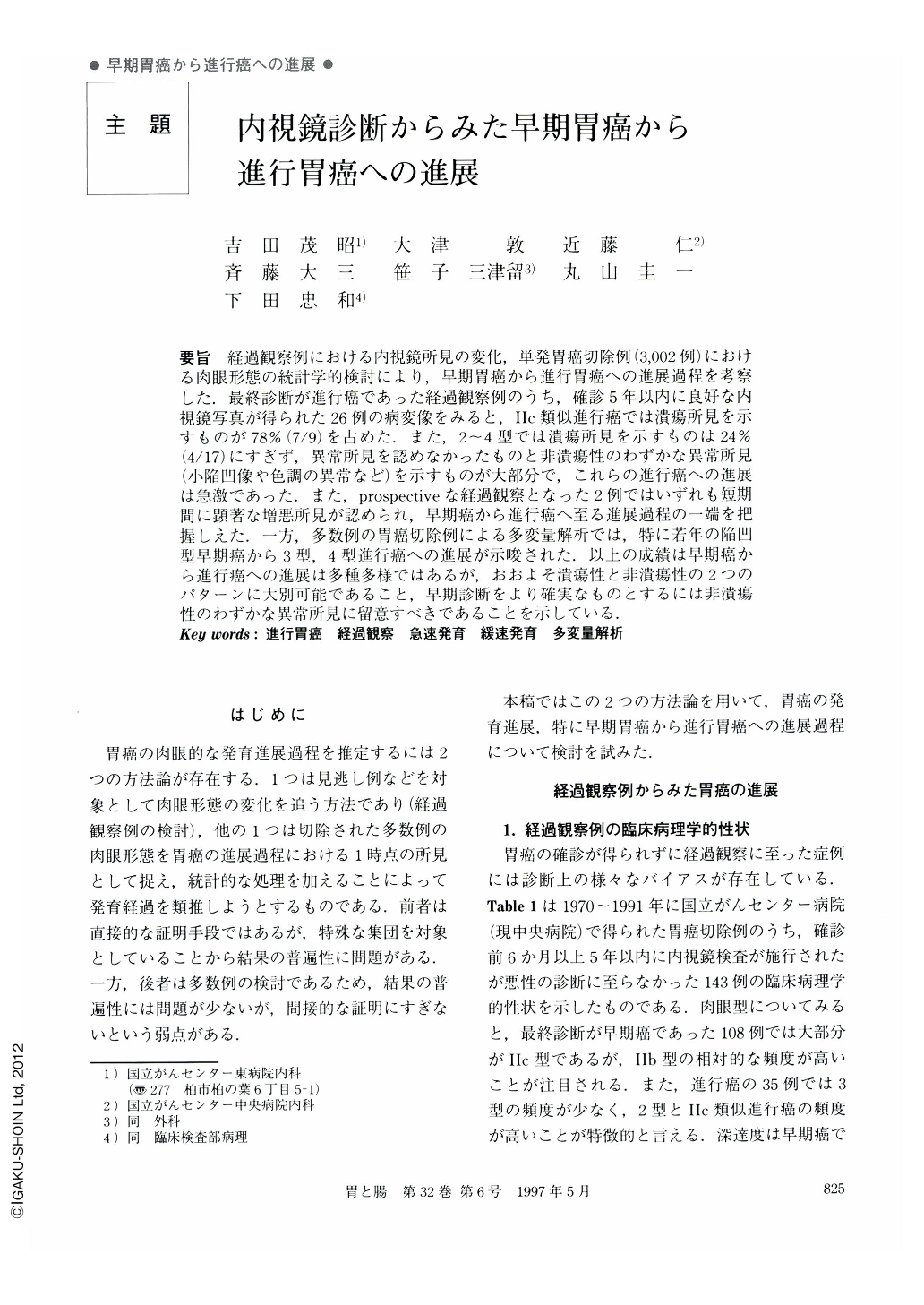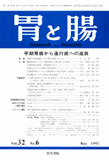Japanese
English
- 有料閲覧
- Abstract 文献概要
- 1ページ目 Look Inside
要旨 経過観察例における内視鏡所見の変化,単発胃癌切除例(3,002例)における肉眼形態の統計学的検討により,早期胃癌から進行胃癌への進展過程を考察した.最終診断が進行癌であった経過観察例のうち,確診5年以内に良好な内視鏡写真が得られた26例の病変像をみると,Ⅱc類似進行癌では潰瘍所見を示すものが78%(7/9)を占めた.また,2~4型では潰瘍所見を示すものは24%(4/17)にすぎず,異常所見を認めなかったものと非潰瘍性のわずかな異常所見(小陥凹像や色調の異常など)を示すものが大部分で,これらの進行癌への進展は急激であった.また,prospectiveな経過観察となった2例ではいずれも短期間に顕著な増悪所見が認められ,早期癌から進行癌へ至る進展過程の一端を把握しえた.一方,多数例の胃癌切除例による多変量解析では,特に若年の陥凹型早期癌から3型,4型進行癌への進展が示唆された.以上の成績は早期癌から進行癌への進展は多種多様であるが,おおよそ潰瘍性と非潰瘍性の2つのパターンに大別可能であること,早期診断をより確実なものとするには非潰瘍性のわずかな異常所見に留意すべきであることを示している.
In order to clarify macroscopically how early cancers progress to advanced ones, we examined the early appearances of cancerous lesions in endoscopic films from followed up cases of advanced gastric cancer (AGC), of which malignancy had not been diagnosed at the previous endoscopy carried out within five years prior to the final examination. In those of Ⅱc-like advanced type, 78% (7/9) were derived from ulcerative lesions. In contrast, in those of 2, 3 and 4 types 75% (12/16) were from nonulcerative lesions, i.e. shallow depression, faint erythematous mucosa and so on, or nonspecific mucosa. The growth patterns of these two groups were apparently different. In the latter group the progression from superficial mucosal to massive invasive lesions was dramatically rapid (within two or three years) in most of the cases as shown in 〔Cases 1~3〕, whereas, endoscopically, the ulcerative lesions in the former group were not markedly changed, except for one case shown as 〔Case 4〕.
In the two cases of early gastric cancer (EGC) in which the patients delayed surgery, the endoscopic appearance of their lesions changed remarkably to that of deep invasive ones during three years in one case 〔Case 7〕 and 30 days in the other one 〔Case 8〕.
From the multivariate analysis examining the correlation of macroscopic types to sex, location and histological type which are stable during the cancer progression, close correlation was observed between the depressed type of EGC in younger patients and type 3 or 4 AGC, as well as that between the Ⅱa + Ⅱc type of EGC and type 2 AGC.
The above may indicate that there are two ways in the progression of early gastric cancer to advanced gastric cancer, i.e. that from ulcerative types and that from nonulcerative types. The endoscopic progression from superficial to massively invasive findings is completed within a short period, except for most ulcerative cancers with fold convergence. In addition, it can be said that Ⅱc type of EGCs in the younger generation have much more potential for progression than those found in older patients.

Copyright © 1997, Igaku-Shoin Ltd. All rights reserved.


